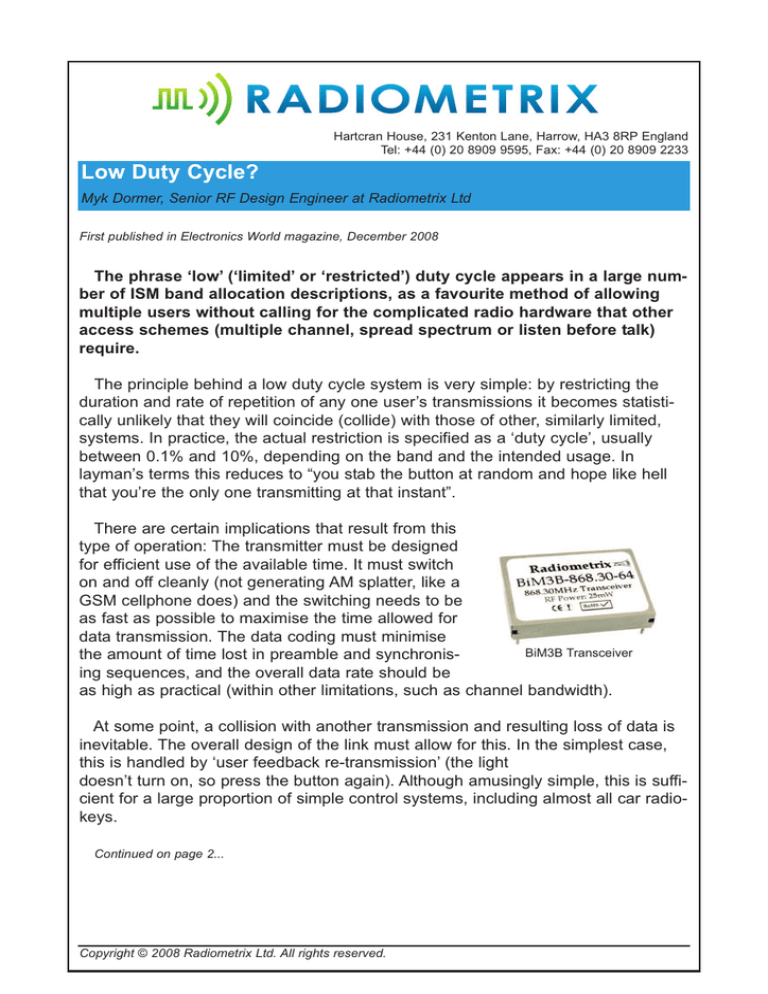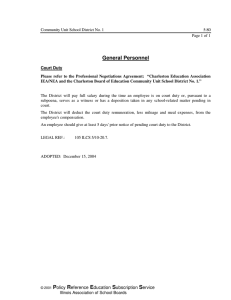
Low Duty Cycle?
Hartcran House, 231 Kenton Lane, Harrow, HA3 8RP England
Tel: +44 (0) 20 8909 9595, Fax: +44 (0) 20 8909 2233
Myk Dormer, Senior RF Design Engineer at Radiometrix Ltd
First published in Electronics World magazine, December 2008
The phrase ‘low’ (‘limited’ or ‘restricted’) duty cycle appears in a large number of ISM band allocation descriptions, as a favourite method of allowing
multiple users without calling for the complicated radio hardware that other
access schemes (multiple channel, spread spectrum or listen before talk)
require.
The principle behind a low duty cycle system is very simple: by restricting the
duration and rate of repetition of any one user’s transmissions it becomes statistically unlikely that they will coincide (collide) with those of other, similarly limited,
systems. In practice, the actual restriction is specified as a ‘duty cycle’, usually
between 0.1% and 10%, depending on the band and the intended usage. In
layman’s terms this reduces to “you stab the button at random and hope like hell
that you’re the only one transmitting at that instant”.
There are certain implications that result from this
type of operation: The transmitter must be designed
for efficient use of the available time. It must switch
on and off cleanly (not generating AM splatter, like a
GSM cellphone does) and the switching needs to be
as fast as possible to maximise the time allowed for
data transmission. The data coding must minimise
BiM3B Transceiver
the amount of time lost in preamble and synchronising sequences, and the overall data rate should be
as high as practical (within other limitations, such as channel bandwidth).
At some point, a collision with another transmission and resulting loss of data is
inevitable. The overall design of the link must allow for this. In the simplest case,
this is handled by ‘user feedback re-transmission’ (the light
doesn’t turn on, so press the button again). Although amusingly simple, this is sufficient for a large proportion of simple control systems, including almost all car radiokeys.
Continued on page 2...
Copyright © 2008 Radiometrix Ltd. All rights reserved.
Where more sophisticated systems are considered, and data integrity must be
maintained, then a more effective means of dealing with data loss is needed.
Sending the same data more than once will reduce (but not eliminate) the
probability of completely losing a vital piece of information. In such a case, the
interval between re-transmissions must not be constant (a randomising function is
required), or there is the risk of another, identical system in close proximity falling
‘in step’ and the retransmissions always colliding.
Where no data loss is allowable (forexample, in a data download application
from a data logger), then a transmit/acknowledge protocol must be used. This
requires transceivers at both ends of the link (opposed to the transmitter/receiver
pair used by the simpler methods) and the transmission of a ‘data received successfully’ message by the destination end after each burst. The failure to receive
such a message within a given time window will then cause the originating unit to
re-send the same data. In this way, the transmission will be repeated until successfully received.
Additionally, once the complexity of a transceiver system has been implemented,
then the user has the option of using other protocols beyond transmitting at random, as required (such as master/slave polling or master synchronised time slots),
provided the actual transmission durations are within the spec limits.
European Duty Cycle Limited SRD Bands
169MHz 0.1% to 10%, depending on the sub-band and transmit power.
433MHz 10% duty cycle, wideband (> 25kHz channel) 10mW transmitters.
(no restrictions on sub-1mW units, or narrowband systems).
868MHz Variously 0.1% to 100%, depending on the sub-band.
2.45GHz RFID allocation 15%.
See ERC-REC 70-03 for more information.
In addition to the duty cycle limits, this specification also states absolute transmission time limits too (otherwise a “10% duty cycleî system could transmit constantly
for a year and then stay quiet for nine...!)
Maximum total time on in any hour:
3.6 seconds 0.1% duty cycle
36 seconds 1 %
360 seconds 10%
Maximum length of any given transmission:
0.72 seconds 0.1% duty cycle
3.6 seconds 1 %
36 seconds 10%
Minimum ‘off’ time between transmissions:
0.72 seconds 0.1% duty cycle
3.6 seconds 1 %
36 seconds 10%
Copyright © 2008 Radiometrix Ltd. All rights reserved.
Page 2
About Radiometrix
Established in 1985 and headquartered in London, Radiometrix continues to be
recognised as the leading global developer of narrow and wideband radio
communication modules. Our diverse product range is suitable for a wide variety of
licensed and licence-exempt ISM/SRD wireless applications, and is available
worldwide through our global sales and distribution network.
For more information on the company, please visit our website:
www.radiometrix.com
Contact Radiometrix
Editorial queries can be sent to press@radiometrix.com
Sales queries can be directed to the sales department: sales@radiometrix.com
Radiometrix Ltd,
Hartcran House,
231 Kenton Lane,
Harrow,
Middlesex,
HA3 8RP,
UK.
Tel: +44 (0) 208-909-9595
Fax: +44 (0) 208-909-2233
Limitation of liability
The information furnished by Radiometrix Ltd is believed to be accurate and reliable. Radiometrix Ltd
reserves the right to make changes or improvements in the design, specification or manufacture of its subassembly products without notice. Radiometrix Ltd does not assume any liability arising from the application or use of any product or circuit described herein, nor for any infringements of patents or other rights of
third parties which may result from the use of its products. This data sheet neither states nor implies warranty of any kind, including fitness for any particular application. These radio devices may be subject to
radio interference and may not function as intended if interference is present. We do NOT recommend
their use for life critical applications. The Intrastat commodity code for all our wireless radio modules is:
8542 6000.
Copyright © 2008 Radiometrix Ltd. All rights reserved.
Page 3





